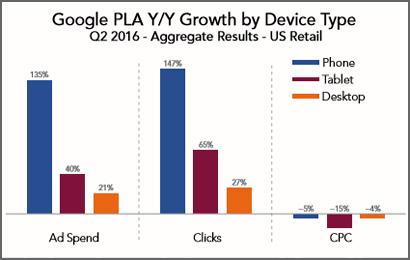Merkle Releases Google Shopping PLA Playbook
by Laurie Sullivan, Staff Writer @lauriesullivan, August 19, 2016

Merkle on Friday released the PLA Playbook, detailing the best practices and advanced strategies for managing Shopping campaigns.
Shopping ads grew significantly during the past few years, with product listing ads contributing 46% of all Google paid search clicks for retailers in the second quarter of 2016. Mobile spend on PLAs grew 135% during the same time frame, per Merkle.
PLAs have become very sucessul for many companies, mainly because they bring an image into the ad. One of the more interesting examples of success in PLAs, in my opinion, comes from Courtney O’Donnell, senior shopping and feed manager at Elite SEM. She works on Jet.com’s Google Shopping account. Jet.com is the ecommerce company — founded in January 2014, and recently acquired by Wal-Mart. I posed this question in an earlier SearchBlog post, but wonder how much did her efforts contribute to Wal-Mart’s decision to acquire the company.
Some of the important key takeaways in the report include advanced shopping strategies like the use of remarketing lists for search ads (RLSA) and Customer Match to target customers at each stage in the purchase cycle. It walks through using query-based targeting to identify and bid more for more valuable shoppers, and how query targeting works in tandem with people-based strategies.
Overall, the playbook focuses on setting up data feeds, how to use tools and features like campaign priorities, custom labels, and product type to structure campaigns tailored to retail business. It also includes tips on incremental growth opportunities even in existing and mature accounts, and how to practice query-based targeting and people-based targeting to optimize campaigns.
For many, mobile strategies lead campaigns. There was a lot of hoopla when Google released the feature mobile bid adjustments, which allow search marketers to modify bids by a percentage, based on device. Brands can assign bid adjustments at the ad group or campaign level.
Mobile bid adjustments range from -90% to 300%. An advertiser also can choose to opt out of mobile Shopping ads with a bid modifier of -100%. For those looking to better understand the process, Merkle provides this example: if a dress shirts campaign on mobile devices drives fewer conversions than on desktop, marketers will want to set a negative mobile bid adjustment. Giving that campaign a -20% bid adjustment would change a $1 bid to $.80 and would result in showing those ads to lower-converting mobile shoppers less frequently.
Marketers can download the PLA Playbook here.
MediaPost.com: Search Marketing Daily
(20)


